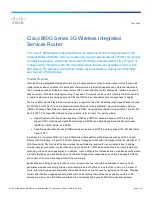
This Device Meets International Guidelines for Exposure to Radio Waves
The C9136I series device includes a radio transmitter and receiver. It is designed not to exceed the limits for
exposure to radio waves (radio frequency electromagnetic fields) recommended by international guidelines.
The guidelines were developed by an independent scientific organization (ICNIRP) and include a substantial
safety margin designed to ensure the safety of all persons, regardless of age and health.
As such the systems are designed to be operated as to avoid contact with the antennas by the end user. It is
recommended to set the system in a location where the antennas can remain at least a minimum distance as
specified from the user in accordance to the regulatory guidelines which are designed to reduce the overall
exposure of the user or operator.
Separation Distance
20 cm (7.87 inches)
The World Health Organization has stated that present scientific information does not indicate the need for
any special precautions for the use of wireless devices. They recommend that if you are interested in further
reducing your exposure then you can easily do so by reorienting antennas away from the user or placing he
antennas at a greater separation distance then recommended.
This Device Meets FCC Guidelines for Exposure to Radio Waves
The C9136I series device includes a radio transmitter and receiver. It is designed not to exceed the limits for
exposure to radio waves (radio frequency electromagnetic fields) as referenced in FCC Part 1.1310. The
guidelines are based on IEEE ANSI C 95.1 (92) and include a substantial safety margin designed to ensure
the safety of all persons, regardless of age and health.
As such the systems are designed to be operated as to avoid contact with the antennas by the end user. It is
recommended to set the system in a location where the antennas can remain at least a minimum distance as
specified from the user in accordance to the regulatory guidelines which are designed to reduce the overall
exposure of the user or operator.
The device has been tested and found compliant with the applicable regulations as part of the radio certification
process.
Separation Distance
27 cm (10.62 inches)
The US Food and Drug Administration has stated that present scientific information does not indicate the
need for any special precautions for the use of wireless devices. The FCC recommends that if you are interested
in further reducing your exposure then you can easily do so by reorienting antennas away from the user or
placing the antennas at a greater separation distance then recommended or lowering the transmitter power
output.
This Device Meets the Industry Canada Guidelines for Exposure to Radio
Waves
The C9136I series device includes a radio transmitter and receiver. It is designed not to exceed the limits for
exposure to radio waves (radio frequency electromagnetic fields) as referenced in Health Canada Safety Code
Cisco Catalyst 9136I Series Access Point Hardware Installation Guide
39
Declarations of Conformity and Regulatory Information
This Device Meets International Guidelines for Exposure to Radio Waves
















































